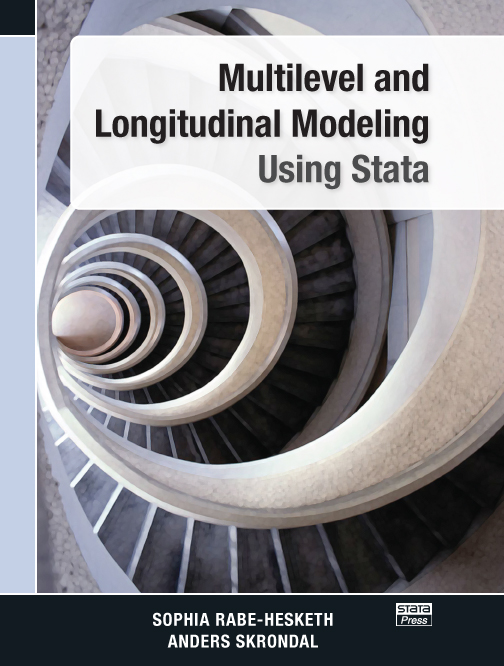关于本站
人大经济论坛-经管之家:分享大学、考研、论文、会计、留学、数据、经济学、金融学、管理学、统计学、博弈论、统计年鉴、行业分析包括等相关资源。
经管之家是国内活跃的在线教育咨询平台!
经管之家新媒体交易平台
提供"微信号、微博、抖音、快手、头条、小红书、百家号、企鹅号、UC号、一点资讯"等虚拟账号交易,真正实现买卖双方的共赢。【请点击这里访问】
TOP热门关键词
书名:multilevelandlongitudinalmodelingusingstata版本:第二版来源:网友扫描,委托上传格式:扫描pdf+ocr大小:19m说明:本书正是此前eblog版主悬赏过的,当时我上传了第一版,此次上传的是第二版。本书设置两个 ...
免费学术公开课,扫码加入 |
书名:multilevel and longitudinal modeling using stata
版本:第二版
来源:网友扫描,委托上传
格式:扫描pdf+ocr
大小:19m
说明:本书正是此前eblog版主悬赏过的,当时我上传了第一版,此次上传的是第二版。
本书设置两个价格,扫描该书的网友不方便上网,委托我上传,由出售帖的到的金钱达3000后,出售帖的价格将改为象征性的1金钱。二楼的出售帖内容与本帖一样,但是给论坛里金钱较多的版友一个捐赠的机会,你们一人捐赠后出售帖价格将改为象征性的1金钱。

Table of contents
Preface(pdf) 1 Linear variance-components models 1.1 Introduction
1.2 How reliable are expiratory flow measurements?
1.3 The variance-components model 1.3.1 Model specification and path diagram
1.3.2 Error components, variance components, and reliability
1.3.3 Intraclass correlation 1.4 Modeling the Mini Wright measurements 1.4.1 Estimation using xtreg
1.4.2 Estimation using xtmixed
1.4.3 Estimation using gllamm
1.4.4 Relative and absolute agreement 1.5 Estimation methods
1.6 Assigning values to the random intercepts 1.6.1 Maximum likelihood estimation Implementation via OLS regression
Implementation via the mean total residual 1.6.2 Empirical Bayes prediction
1.6.3 Empirical Bayes variances 1.7 Summary and further reading
1.8 Exercises 2 Linear random-intercept models 2.1 Introduction
2.2 Are tax preparers useful?
2.3 The longitudinal data structure
2.4 Panel data and correlated residuals
2.5 The random-intercept model 2.5.1 Estimation using xtreg
2.5.2 Estimation using xtmixed 2.6 Different kinds of effects in panel models 2.6.1 Between-taxpayer effects
2.6.2 Within-taxpayer effects
2.6.3 Relations among the estimators 2.7 Endogeneity and between-taxpayer effects
2.8 Residual diagnostics
2.9 Summary and further reading
2.10 Exercises 3 Linear random-coefficient and growth-curve models 3.1 Introduction
3.2 How effective are different schools?
3.3 Separate linear regressions for each school
3.4 The random-coefficient model 3.4.1 Specification and interpretation of a random-coefficient model
3.4.2 Estimation and prediction using xtmixed Estimation of random-intercept model
Estimation of random-coefficient model
Empirical Bayes prediction using xtmixed 3.4.3 Estimation and prediction using gllamm Estimation of random-intercept model
Estimation of random-coefficient model
Empirical Bayes prediction 3.5 How do children grow?
3.6 Growth-curve modeling 3.6.1 Observed growth trajectories
3.6.2 Estimation using xtmixed Quadratic growth model with random intercept
Quadratic growth model with random intercept and random slope
Including a child-level covariate 3.6.3 Estimation using gllamm Quadratic growth model with random intercept
Quadratic growth model with random intercept and random slope
Including a child-level covariate 3.7 Two-stage model formulation 3.7.1 Model specification
3.7.2 Estimation 3.8 Prediction of trajectories for individual children
3.9 Complex level-1 variation or heteroskedasticity
3.10 Summary and further reading
3.11 Exercises 4 Dichotomous or binary responses 4.1 Models for dichotomous responses 4.1.1 Generalized linear model formulation
4.1.2 Latent-response formulation Logistic regression
Probit regression 4.2 Which treatment is best for toenail infection?
4.3 The longitudinal data structure
4.4 Population-averaged or marginal probabilities
4.5 Random-intercept logistic regression
4.6 Subject-specific vs. population-averaged relationships
4.7 Maximum likelihood estimation using adaptive quadrature 4.7.1 Some practical considerations 4.8 Empirical Bayes (EB) predictions 4.8.1 EB prediction of random effects
4.8.2 EB prediction of response probabilities 4.9 Other approaches to clustered dichotomous data 4.9.1 Conditional logistic regression
4.9.2 Generalized estimating equations (GEE) 4.10 Summary and further reading
4.11 Exercises 5 Ordinal responses 5.1 Introduction
5.2 Cumulative models for ordinal responses 5.2.1 Generalized linear model formulation
5.2.2 Latent-response formulation
5.2.3 Proportional odds
5.2.4 Identification 5.3 Are antipsychotic drugs effective for patients with schizophrenia?
5.4 Longitudinal data structure and graphs 5.4.1 The longitudinal data structure
5.4.2 Plotting cumulative proportions
5.4.3 Plotting cumulative logits and transforming the time scale 5.5 A proportional-odds model 5.5.1 Model specification
5.5.2 Estimation 5.6 A random-intercept proportional-odds model 5.6.1 Model specification
5.6.2 Estimation 5.7 A random-coefficient proportional-odds model 5.7.1 Model specification
5.7.2 Estimation 5.8 Marginal and patient-specific probabilities 5.8.1 Marginal probabilities
5.8.2 Patient-specific cumulative response probabilities 5.9 Do experts differ in their grading of student essays?
5.10 A random-intercept model with grader bias 5.10.1 Model specification
5.10.2 Estimation 5.11 Including grader-specific measurement error variances 5.11.1 Model specification
5.11.2 Estimation 5.12 Including grader-specific thresholds 5.12.1 Model specification
5.12.2 Estimation 5.13 Summary and further reading
5.14 Exercises 6 Counts 6.1 Introduction
6.2 Types of counts
6.3 Poisson model for counts
6.4 Did the German health-care reform reduce the number of doctor visits?
6.5 Longitudinal data structure
6.6 Poisson regression ignoring overdispersion and clustering 6.6.1 Model specification
6.6.2 Estimation 6.7 Poisson regression with overdispersion but ignoring clustering 6.7.1 Using a level-1 random intercept Model specification
Estimation 6.7.2 Quasilikelihood Specification
Estimation 6.8 Random-intercept Poisson regression 6.8.1 Model specification
6.8.2 Estimation 6.9 Random-coefficient Poisson regression 6.9.1 Model specification
6.9.2 Estimation 6.10 Other approaches to clustered counts 6.10.1 Conditional Poisson regression
6.10.2 Generalized estimating equations (GEE) 6.11 Which Scottish countries have a high risk of lip cancer?
6.12 Standardized mortality ratios
6.13 Random-intercept Poisson regression 6.13.1 Model specification
6.13.2 Estimation
6.13.3 Introducing a county-level covariate
6.13.4 Prediction 6.14 Nonparametric maximum likelihood estimation 6.14.1 Specification
6.14.2 Estimation
6.14.3 Prediction 6.15 Summary and further reading
6.16 Exercises 7 Higher level models and nested random effects 7.1 Introduction
7.2 Which method is best for measuring expiratory flow?
7.3 Two-level variance-components models 7.3.1 Model specification
7.3.2 Estimation 7.4 Three-level variance-components models 7.4.1 Model specification
7.4.2 Different types of intraclass correlation
7.4.3 Three-stage formulation
7.4.4 Estimation using xtmixed
7.4.5 Prediction using xtmixed 7.5 Did the Guatemalan immunization campaign work?
7.6 A three-level logistic random-intercept model 7.6.1 Model specification
7.6.2 Different types of intraclass correlations for the latent responses
7.6.3 Three-stage formulation
7.6.4 Estimation
7.6.5 Introducing a random coefficient at level 3
7.6.6 Prediction 7.7 Summary and further reading
7.8 Exercises 8 Crossed random effects 8.1 Introduction
8.2 How does investment depend on expected profit and capital stock?
8.3 A two-way error-components model 8.3.1 Model specification
8.3.2 Intraclass correlations
8.3.3 Estimation
8.3.4 Prediction 8.4 How much do primary and secondary schools affect attainment at age 16?
8.5 An additive crossed random-effects model 8.5.1 Specification
8.5.2 Estimation 8.6 Including a random interaction 8.6.1 Model specification
8.6.2 Intraclass correlations
8.6.3 Estimation
8.6.4 Some diagnostics 8.7 A trick requiring fewer random effects
8.8 Summary and further reading
8.9 Exercises A Syntax for gllamm, eq, and gllapred B Syntax for gllamm C Syntax for gllapred D Syntax for gllasim References Author index
(pdf) Subject index
(pdf)
[此贴子已经被wesker1999于2008-11-26 1:23:30编辑过]
「经管之家」APP:经管人学习、答疑、交友,就上经管之家!
免流量费下载资料----在经管之家app可以下载论坛上的所有资源,并且不额外收取下载高峰期的论坛币。
涵盖所有经管领域的优秀内容----覆盖经济、管理、金融投资、计量统计、数据分析、国贸、财会等专业的学习宝库,各类资料应有尽有。
来自五湖四海的经管达人----已经有上千万的经管人来到这里,你可以找到任何学科方向、有共同话题的朋友。
经管之家(原人大经济论坛),跨越高校的围墙,带你走进经管知识的新世界。
扫描下方二维码下载并注册APP

免流量费下载资料----在经管之家app可以下载论坛上的所有资源,并且不额外收取下载高峰期的论坛币。
涵盖所有经管领域的优秀内容----覆盖经济、管理、金融投资、计量统计、数据分析、国贸、财会等专业的学习宝库,各类资料应有尽有。
来自五湖四海的经管达人----已经有上千万的经管人来到这里,你可以找到任何学科方向、有共同话题的朋友。
经管之家(原人大经济论坛),跨越高校的围墙,带你走进经管知识的新世界。
扫描下方二维码下载并注册APP

您可能感兴趣的文章
- Stata软件培 ... | stata中,非平衡面板数据单位根检 ...
- Stata软件培 ... | 求助Stata.12 数据保存的问题
- Stata软件培 ... | 请问stata回归结果中有一项变量显 ...
- Stata软件培 ... | 【Stata】八月特训_三天掌握Stat ...
- Stata软件培 ... | 请教下用STATA做面板logit分析问 ...
- Stata软件培 ... | 急!!邱高手解答!!stata做出的 ...
- Stata软件培 ... | [下载] Regression with Stata(w ...
- Stata软件培 ... | Stata公司新出版图书:The Workf ...
人气文章
本文标题:multilevel and longitudinal modeling using stata 第二版
本文链接网址:https://bbs.pinggu.org/jg/ruanjianpeixun_stataruanjianpeixun_387957_1.html
2.转载的文章仅代表原创作者观点,与本站无关。其原创性以及文中陈述文字和内容未经本站证实,本站对该文以及其中全部或者部分内容、文字的真实性、完整性、及时性,不作出任何保证或承若;
3.如本站转载稿涉及版权等问题,请作者及时联系本站,我们会及时处理。



